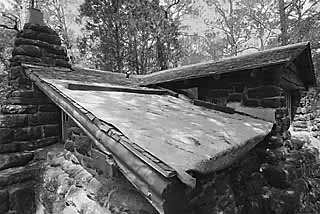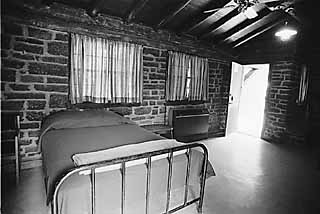https://www.austinchronicle.com/news/1999-04-16/521797/
No Green Acres
Crumbling Landmarks
April 16, 1999, News
Last year, the Texas Historical Commission (THC) studied 42 state historical parks and found them to be in a downward spiral of budget and staff crunches. The deterioration of these parks has led to an inevitable reduction in visitors.
|
|
With more than 300 years of European colonization and centuries of Native American cultures, Texas is second only to California in the number of state-preserved historical sites. These sites serve the citizens of the state as research facilities, as well as educational classrooms. But the THC report says threats are looming. At the Casa Navarro State Historical Site in San Antonio, budget constraints have forced the parks agency to reduce operating hours to five days a week, with limited full-time staff. The THC recommends an infusion of $105,000 for major repairs and improvements.
The site has great historical significance. It was the home of rancher and Texas patriot Jose Antonio Navarro, the only Mexican to sign the Texas Declaration of Independence and the constitutions of the Republic of Texas and the state. The site's 100-year-old buildings are an example of frontier Spanish architecture in Texas and a memorial to Hispanic Tejanos.
In West Texas, at Hueco Tanks State Park near El Paso, irreplaceable Indian pictographs have been closed to visitors except those on special guided tours. The THC recommends $920,000 in capital improvements to the park, including an increase of $60,000 in the annual budget for visitor programs.
And there are more mundane problems, as well. At Goliad State Park in southeast Texas, the primitive camping area and a hiking trail may be closed for much of the summer due to damage caused by last October 's floods. The park simply can't afford to remove the debris that was left by the flood waters. "You can't budget for that kind of thing," said James Hudnall, the park's manager.
Meanwhile, at Bastrop State Park, manager Brent Leisure says the tarp on Cabin 5 should be coming off soon. TPWD has allocated $25,000 to put new roofs on five of the park's cabins. But Leisure says he is more concerned about the things that visitors don't see, things like sewage lines that need replacing -- at a cost of $800,000. Once those repairs are completed, Leisure said, visitors will be able to "flush the toilets and be sure it's going to work."
Too Little to Go Around
Despite hard times at TWPD, Rep. Rob Junell, D-San Angelo, the chairman of the powerful House Appropriations Committee, has little compassion for the agency's plight. Asked about the agency's budget, Junell replies, "Should we raise it some? Yeah. They have more needs, but so does everybody in state government, including education, MHMR, and children's health care."
Junell expressed frustration, in fact, that TPWD hasn't acted more quickly to use the money that it has been authorized to spend. He points out that the Legislature gave TPWD $60million worth of bonding authority during the 1997 legislative session to address the park infrastructure problem. The bonding authority is in addition to the agency's annual budget of $150 million. The bonds will be repaid by the agency through additional general revenue appropriations. But Junell thinks TPWD has been too slow to spend the bond money. So far, Junell says, TPWD has spent just $3.1 million of the $60 million on maintenance projects.
|
|
TPWD officials admit that they have not been spending money as fast as Junell would like. So far, the agency has issued $30 million worth of bonds. Another $30 million will be issued over the next two years. TPWD staffers are leery of talking about the Legislature for fear of irritating people like Junell. When asked why it is taking so long to spend the bond money, one agency staffer who requested anonymity said the agency has numerous projects that are being designed, and added, "We have developed an expenditure strategy."
While the bonds are of critical importance, TPWD has been developing other ways to boost park funding. In 1991, Sansom helped launch the Parks and Wildlife Foundation of Texas, a nonprofit organization that partners with TPWD to preserve the state's natural and cultural heritage through private funding. And the department instituted the Entrepreneurial Budget System to encourage park managers to find new funding by letting them keep funds raised from tours, gift shops, and special programs.
Other programs have had varying results. In 1991, the agency launched the Conservation Passport, which allows holders to get free admission at parks and other benefits. By 1995, the agency sold over 123,000 of the passes and brought in $3 million additional dollars. But when they changed the program's benefits and raised the price from $25 to $50, subscriptions and revenues fell. Last year, they sold 46,800 passes, bringing in $2.3 million.
In 1996, the department changed its entrance fee policies from a per vehicle fee to a per person fee. In 1998, in an effort to increase funding for individual parks, TPWD established the Lone Star Legacy, which creates an endowment fund for every state-owned park in Texas. As an endowment, only the interest generated from the funds can be spent, ensuring that donations will continue to benefit the parks in perpetuity. Donations may be made to the fund or to a particular state park. But the fact that the state has to resort to the endowment program indicates just how desperate things are. After all, if TPWD had adequate funding from the Legislature, it wouldn't need the endowment program.
Sporting Goods Tax
TPWD's biggest ally at the Capitol may be Sen. J.E. "Buster" Brown, R-Lake Jackson. Brown has introduced a bill that could allow TPWD to obtain an additional $33 million per year in revenue from a tax on sporting goods. His SB 286 would remove the limit on the amount of money that the agency can get from sales taxes that are assessed on everything from fishing lures, to tents, to life jackets. Estimates for 1999 predict that the sporting goods tax will collect $65.3 million. But the amount set aside for parks is capped at $32 million -- and half of that money is shared with the Local Parks Fund used by the department to give grants to city and county parks. The other $33 million collected from the tax goes into the state's general revenue fund. If the department were given the entire sporting goods tax, it would be less than 1% of the total state budget and would meet the department's critical needs and help it prepare for the future.
Brown says his measure is needed "because of our deteriorating parks system. A lot of it has been ignored over the years so the infrastructure is really suffering." But his bill is still stuck in the Senate Finance Committee and is unlikely to become law, largely because of Junell's opposition. "I have a hard time seeing how a kid buys a pair of Adidas tennis shoes to play basketball in, what connection that has to a state park," Junell said recently. "So I'd say we are not going to uncap the dedication on sporting goods."
Despite his opposition to changes in the sporting goods tax, Junell does plan to get TPWD more money. "I'm committed to help get them another $34 million," he said on Tuesday, when the House approved a $97 billion state budget. While Sen. Bill Ratliff, R-Mt. Pleasant, the chairman of the Senate Finance Committee, could not confirm Junell's estimate, he agreed that more money was in order for the agency. "They are going to get considerably more funding," he said.
Other States Spend More
While Texas legislators are planning to up the ante for parks in the state, other states are spending hundreds of millions of dollars to upgrade their existing parks and buy additional land.
For instance:
- In Wisconsin, Republican Gov. Tommy Thompson has announced a $515 million program to acquire and manage open land and to help localities save green space.
- In Florida, 70% of voters supported a constitutional amendment that will allow the state's multimillion dollar land acquisition program to continue. The amendment, which appeared on the November ballot, was endorsed by Gov. Jeb Bush and other key state politicians.
- In Pennsylvania, Republican Gov. Tom Ridge has announced a five-year, $1.3 billion initiative called Growing Greener that includes spending $425 million on a new environmental stewardship program, plus $44 million for more open space protection, and $900 million to promote sound land use policies.
- In New Jersey, voters last November approved a 10-year, $1.5 billion spending package for open-space preservation. Supported strongly by Republican Gov. Christine Todd Whitman, the plan will buy development rights to farms, buy recreational facilities, and provide loans and grants to municipalities for open space preservation. TheNew York Times says Whitman has "made protecting open space the primary issue -- and perhaps her legacy -- for the state."
- In New York, Republican Gov. George Pataki supported a successful 1996 bond program that will spend $150 million on open space acquisition and another $100 million on state and local parks.
Unfortunately, Texas hasn't had a governor who was really interested in parks since John Connally, who tripled the budget for parks maintenance and development in the early Sixties. Since that time, parks have been a stepchild of the legislative process, with few politicos willing to go to bat for TPWD.
Texas would do well to follow the example set by Florida. Since 1990, the state has preserved more than one million acres of open space. The state now spends some $300 million per year to manage three million acres of state-owned land, and it's planning to continue buying additional acreage. Additionally, Florida's legislature is considering a spending package that would have the state setting aside $300 million per year on acquisition for the foreseeable future. "Both native and transplant Floridians alike have seen one too many strip malls and shopping centers go up in the last patch of woods," says Ruark Cleary, land acquisition coordinator for Florida's Department of Environmental Protection. "In Florida, we have high population growth and people are seeing it disappear. People want to have something to show their children what real nature looks like."
Like Florida, Texas is experiencing rapid population growth, with much of it occurring in metropolitan areas. And yet, TPWD is unprepared to deal with the increasing number of newcomers. "What better way to spend public money than on public land?" asks Scott Royder, director of communications and grassroots services for the Lone Star chapter of the Sierra Club. "Parks have always had strong support among the voters, but for some reason, politicians ignore that." And Royder says the reason our parks are being ignored is clear. "The crisis in the state parks is really a crisis in leadership. Governors in other states, like Christine Todd Whitman in New Jersey and Jeb Bush in Florida, have pushed hard for land acquisition and preservation. Here in Texas, we don't have anyone pushing hard for parks. And until we get that leadership, these problems won't go away."
Copyright © 2024 Austin Chronicle Corporation. All rights reserved.


